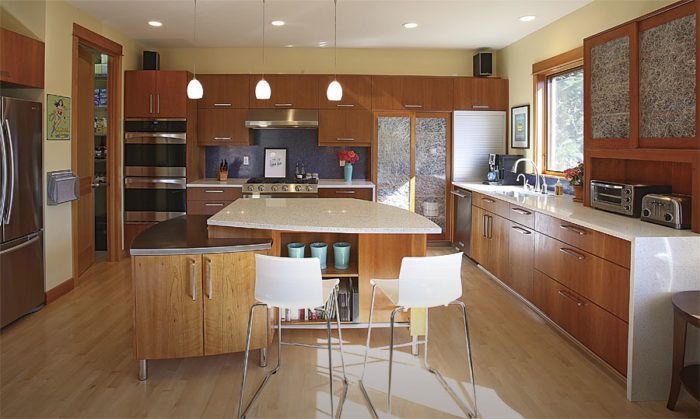Tailgate Interview: Richard Shugar
This principal at 2Form Architecture in Oregon is driven by personal and collaborative design.

Describe your approach to kitchen and bath design.
I approach kitchen and bath design no differently than I would designing a home. I work hard to understand how people want to use the space. In a kitchen, for example, I look at what their living or cooking patterns are like. It’s not always just about the specifics of how the kitchen is laid out, like where do the pots and forks go, but how the kitchen relates to the rooms adjacent to it and also the outdoor spaces. What are you actually looking at when you’re at the sink? When you’re cooking, are you looking at anything, or is cooking more of an introspective experience? In the kitchen that’s featured in this issue, the homeowners wanted to share the preparation for cooking with others, and that’s why the island doesn’t have a place to cook.
Kitchens are very public household spaces, and baths are very private.
Bathing is a very tactile experience. I mean that in terms of textures. Unlike when you’re in a kitchen, your body comes into physical contact with a bathroom. It’s about what you touch with your hands; it’s what your body feels connecting with the water. You can immerse yourself in a bathroom physically and experientially.
Baths can be as unique as kitchens. Some bathroom designs require more discussion and thought than others, but they are more about creating a space of solace and sensation. A kitchen is a more functional space.
The reason I love residential architecture is because no two houses are the same, and people are more emotionally connected to what we are designing than with most commercial projects I work on.
Say more about the emotional connection to a home.
The design work of a home is a reflection of who my clients are and how they want to live, and that’s where the emotional connection to the experience of their house comes from. The other emotional connection is that I’m working with their life savings. It’s their money that they’ve worked so hard for. I’m very sensitive to that fact, and I try to give them the most value that I possibly can with their budget.
In designing a kitchen, what do you do to identify your client’s needs?
I have a list of questions specific to kitchens that I go through with clients. For example, it asks how they cook. For a lot of people, cooking is not a central part of their lives; I have other clients who are chefs. One client might use a microwave all the time, while another insists on having a burner that simmers. That really affects the importance of and the location of the cooking experience.
I also ask about the large and small appliances they have and how often they use them. Are these appliances something they want to have on display? Coffeemakers are an excellent example. Many clients want coffeemakers hidden away in an appli ance garage, but I had one client with a beautiful coffeemaker who wanted it on display like a showpiece.
The kitchen probably reveals more about a client than any other space in a house. It’s where clients feel like they have the most input.
What are some interesting materials you’ve worked with?
For the project in this issue, I used a blue Alkemi material for the backsplash. The shade of blue complements the cherry wood, and there are recycled aluminum shavings in it that complement the appliances and the resin panels in the cabinets. This works in a number of ways. Materials like that help me make decisions. As a designer, one of the hardest things for me is an empty canvas. I look for design elements that help thread a larger design idea together, and I guess that’s what led me to that backsplash material.
What do form and function mean to you?
All buildings and spaces begin with a function. But how do we get to a place where what we design doesn’t simply provide a function but elevates one’s experience of what that function is? In some ways, it’s the difference between engineering and architecture. Engineering is the most efficient way to meet the particular functional requirements of a particular project or problem, and architecture is meeting those requirements in an aesthetic way. Architecture is far more than solving puzzles; it’s about creating experiences.
Where do you tend to draw your inspiration from?
Past teachers, past employers, clients, natural surroundings, colleagues, travels, reading. People can choose to be inspired or not, but I try to live my life with my eyes wide open. I see the world through a series of experiences, so I am very aware of my surroundings. Because of that, I am inspired at times I would never have expected.
Fine Homebuilding Recommended Products
Fine Homebuilding receives a commission for items purchased through links on this site, including Amazon Associates and other affiliate advertising programs.

All New Kitchen Ideas that Work

The New Carbon Architecture: Building to Cool the Climate

Homebody: A Guide to Creating Spaces You Never Want to Leave


























View Comments
up to I saw the paycheck which had said $8845 , I have faith that my friends brother woz like actualy erning money part-time on their apple labtop. . there aunt had bean doing this 4 only 7 months and resently took care of the morgage on there mini mansion and bought themselves a Lancia . view it now....
======== http://www.centerpay70.com
Very Good Kitchens!!